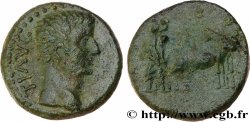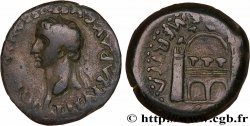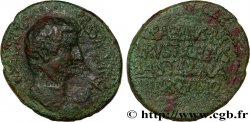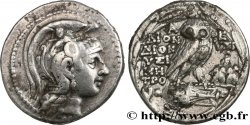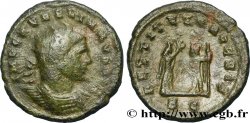brm_942355 - TIBERIO Denier
No disponible.
Artículo vendido en nuestra tienda (2024)
Precio : 50.00 €
Artículo vendido en nuestra tienda (2024)
Precio : 50.00 €
Tipo : Denier
Fecha: c. 33-37
Nombre del taller / ciudad: Lyon
Metal: plata
Milésimas de pureza : 950 ‰
Diámetro: 16 mm
Eje de acuñación: 12 h.
Peso: 2,71 g.
Comentarios sobre el estado de conservación:
Flan un peu court et centré. Usure très importante, particulièrement au revers. Patine grise
N° en los catálogos de referencia :
Anverso
Titulatura del anverso: TI CAESAR DIVI - AVG F AVGVSTVS.
Descripción del anverso: Tête laurée de Tibère à droite (O*).
Traducción del anverso: “Tiberius Cæsar Divi Augusti Filius Augustus”, (Tibère César fils du divin Auguste, auguste).
Reverso
Titulatura del reverso: PONTIF - MAXIM.
Descripción del reverso: Pax (la Paix) ou Livie assise à droite sur un siège décoré, tenant une branche d'olivier de la main gauche et de la droite un long sceptre.
Traducción del reverso: “Pontifex Maximus”, (Grand pontife).
Comentario
Poids léger. Comme pour le denier d'Auguste, cette pièce appartient à l'atelier impérial de Lyon et ce type de denier a circulé pendant pratiquement un siècle. Il se rencontre très souvent avec des monnaies gauloises de la phase terminale dans les fouilles archéologiques. C’est la monnaie romaine la plus courante en Gaule pour les Julio-Claudiens. La cinquième émission se caractérise par un socle représenté par une seule ligne et les pieds du siège sont ornés de fleurons ; les pieds de Livie reposent sur un tabouret, invisible sur notre exemplaire ; au droit, les rubans de la couronne de type 3 retombent en petites ondulations, le portrait reste réaliste.
Lightweight. As with the Augustus denarius, this piece belongs to the imperial workshop of Lyon and this type of denarius circulated for almost a century. It is very often encountered with Gallic coins from the terminal phase in archaeological excavations. It is the most common Roman coin in Gaul for the Julio-Claudians. The fifth issue is characterized by a base represented by a single line and the legs of the seat are decorated with fleurons; Livia's feet rest on a stool, invisible on our copy; on the right, the ribbons of the type 3 crown fall in small undulations, the portrait remains realistic
Lightweight. As with the Augustus denarius, this piece belongs to the imperial workshop of Lyon and this type of denarius circulated for almost a century. It is very often encountered with Gallic coins from the terminal phase in archaeological excavations. It is the most common Roman coin in Gaul for the Julio-Claudians. The fifth issue is characterized by a base represented by a single line and the legs of the seat are decorated with fleurons; Livia's feet rest on a stool, invisible on our copy; on the right, the ribbons of the type 3 crown fall in small undulations, the portrait remains realistic








 Informar de un error
Informar de un error Imprimir la página
Imprimir la página Comparte mi selección
Comparte mi selección Haz una pregunta
Haz una pregunta Consignar / vender
Consignar / vender
 Descriptivo
Descriptivo
